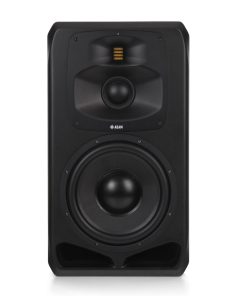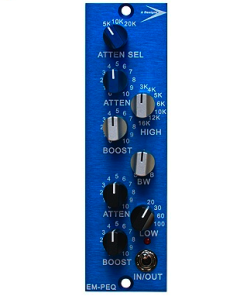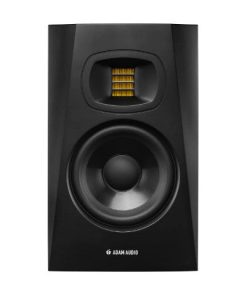Amphion One12 Passive Studio Monitor Amphion
$ 825,00 $ 206,25
Amphion One12 Passive Studio Monitor
The Amphion One12 is a 2-way passive monitor with a 1″ titanium dome tweeter in a Corian waveguide, and 4.5″ aluminum woofer, with a passive radiator for controlled bass .
At one time or another, every engineer, with the notable exception of Abbey Road’s Ken Scott, have advised, or been advised of the benefits of mixing at low volumes. The advantages being longer mix sessions due to less ear fatigue, taking the room acoustics out of the equation, and the ability to hear everything in greater detail. Amphion, in agreement with this concept, designed the One12 to reproduce program material with superb imaging at low volumes. Since the 4.5″ One12 is designed for small rooms, it’s important to recognize that bass is exaggerated in small rooms as volume increases, which leads to thin mixes as you compensate. The One12 is designed to behave much like a set of headphones, enabling you to mix more accurately by revealing all of the fine details. To achieve Amphion’s design philosophy of neither adding to or taking anything away program material, the One12 uses a 1″ (25mm) titanium dome tweeter set in a Corian waveguide. The tweeter is meticulously aligned with a 4.5″ (115mm) woofer, which works in conjunction with a passive radiator to deliver surprisingly tight and even lows for such small speakers. This approach, combined with a very low crossover at 1.6kHz, ensures a rock-solid “phantom” center image, exceptional time and phase coherence, spectacular 3D soundstage and imaging, and an extremely wide and deep sweet spot.
Amphion One12—Just the Facts:
- First-class resolution, imaging, sweet spot width, and depth in a small but powerful package
- Point-source behavior due to 1.6kHz crossover and proprietary Corian waveguide
- Compact studio monitors created for low-volume performance and superb imaging
- Translation at its best, from bedroom studios to commercial studios to PA monitoring
Amphion One12—Behind the Grille
Amphion monitors are designed and hand-built by people dedicated to bring you sound in all its natural glory—nothing added, nothing taken away, just the beauty of sound as it occurs in life—in Amphion’s view, music is already as beautiful as it has to be and doesn’t require monitors to enhance it, but rather, to get out of its way. These small One12 monitors provide an amazingly correct translation to much bigger mixing and mastering studio systems, home audio setups, or even large PA systems. Many other monitors fall apart at low listening volume, but the One12, due to its passive radiator and proprietary waveguide, enable it to sound equally solid at any volume. The One12 also makes it easier to hear compression, EQ, and other types of processing that become obscured at higher levels.
Controlled dispersion via custom Corian waveguide
According to Amphion founder, Anssi Hyvönen, point-source is the only way to properly reproduce sound. Even though Amphion monitors don’t look like it, they behave like point-source monitors due to the crossover at 1.6kHz, which leaves the critical listening range of 2kHz to 5kHz untouched. Additionally, the Corian waveguide deals with the physical properties of point-source monitoring.
Amphion’s custom waveguide is responsible for the One12’s wide dispersion and simultaneous ability to physically act as a point-source monitor. While this would appear to be counterintuitive, since a point-source monitor would have a tweeter inside a woofer, the goal of the waveguide is to eliminate the phase shift that would otherwise occur due to the physical distance between tweeter and driver. Point-source monitoring also eliminates the need for additional time-alignment circuitry. However, the downside of point-source monitors is that having the tweeter inside the woofer reduces dispersion and makes for a very narrow sweet spot. Amphion’s proprietary waveguide solves the problems of phase shift, time-alignment, and narrow dispersion.
To design their waveguide, Amphion chose Corian, a product created by DuPont for, believe it or not, kitchen and bathroom surfaces. Corian not only rivals the density of granite, it’s non-porous, highly reflective, and can be seamlessly molded into limitless forms via a process called thermoforming. Corian also lasts a lifetime. The Corian waveguide’s shape is determined via computer modeling and simulations to enable the One12’s tweeter and woofer to function like a point source monitor.
PAD Pro tech tip: Mixing quietly in mono from a single point-source monitor (such as the old single-speaker Auratones), is one of the best-kept secrets for mix balance and translation. It’s much easier to judge the balance of two instruments superimposed on one another in mono than when they are several feet apart. It’s also easier to judge reverb amounts. So do your panning, balancing, and reverbs in mono, and when you switch back to stereo, everything will open up, with greater clarity and size. The big secret is to use only one point-source monitor in mono.
Passive radiator bass enhancement
Another design philosophy adhered to by Amphion’s Anssi Hyvönen is that in his view, ported monitors should be banned from music making. The upside of ported speakers is that they can output more impressive low end than infinite-baffle systems (sealed cabinets), though they exhibit a steeper bass roll-off. The downside is that the waves emanating from them can make noise and interfere up the spectrum through the low mids and midrange. There’s also a possibility of smearing transients, as well as produce a phenomenon called one-note bass, wherein the resonant frequency of the cabinet overtakes the low end.
Amphion’s solution is the use of a passive radiator, which works much like the bass reflex in order to increase bass response in an otherwise too small cabinet. The radiator is a diaphragm used to cover an inconveniently large port. It also reduces port turbulence, which can interfere with the direct sound of the drivers. Amphion uses passive radiators in a sealed cabinet, which maintains the same low-frequency response regardless of volume—hence the One12’s ability to remain true to the source at low levels.
Applications
The One12 is a perfect fit for home studios, small post-production edit bays, mobile trucks, or FOH where space is at a premium. Designed for any pro audio application, in the studio, or on-the-go, these nearfields take the room out of the equation and allow you to listen to music in its pure form, not affected by the surrounding acoustics. One12 studio monitors are like a large pair of high-resolution headphones that the whole production team can listen to at once.
What the pros are saying about Amphion
“… may be the best small studio speakers ever!”
Producer-engineer-mixer, Jacquire King (Norah Jones, Kings Of Leon, Tom Waits)
“Unbelievably portable and they sound amazing.”
—Producer, songwriter, and recording engineer, Rob Hoffman (Quincy Jones, Michael Jackson, Christina Aguilera)
“… take my Amphions. Just prepare for a battle.”
Petri Alanko—composer, musician, and producer
“Absolutely fantastic for such a small monitor.”
Jonathan Ojeda—recording artist, mixing, and mastering engineer
Amph up your ears with a pair of Amphion One12 monitors and hear your music as you intended. Order yours today. For more information, call or chat online with your PAD Professional.
Specifications
- Operating principle: Two-way, passive radiator
- Drivers: 1″ (25mm) titanium tweeter; 4-1/2″ (120mm) aluminum woofer
- Crossover point: 1.6kHz
- Sensitivity: 84dB @ 2.83V/1m
- Frequency response: 78Hz–20kHz ±3dB
- Power recommendation: 20 – 100 W
- Weight: 13 lb. (6 kg)
- Handmade in Finland
| Version | Single Speaker, Pair |
|---|
Prompt Delivery and Professional Packaging
Our long-standing partnership with UPS FedEx DHL and other global carriers lets us offer a range of shipping services. Our warehouse staff is extremely skilled and will package your items according to our precise and exact specifications. Your goods will undergo an extensive inspection and be safely packaged prior to being sent out. Each day, we ship to thousands of customers in many countries. The fact that we are committed to becoming the biggest online retailer in the World is clear. These warehouses are in Europe in the same way as they are in USA.
Note: Orders that include more than one item are assigned a processing period depending on the item.
Before shipping, we will inspect thoroughly the items you have ordered. Most orders are shipped within 48 hours. Expected delivery time is between 3-7 days.
Returns
Stock is dynamic. It's not entirely managed by us since we are involved with multiple entities, including the factory and the storage. The actual stock can change at any moment. It is possible that your order may be out of stock once the order has been placed.
Our policy lasts for 30 days. We cannot exchange or refund your order if it has been 30 days from the date of purchase.
For your item to be returned it must be in its original packaging, unopened and in the condition you received it. The item must be in its original packaging.
Related products
Monitor
Monitor Systems
Recording Equipments
Monitor
Microphones
Monitor
Accessories
500 Series
Microphones
Recording Equipments
Microphones
500 Series
Recording Equipments
Subwoofer
Accessories
Monitor Systems
Monitor
Headphones
Accessories
Equalizers
Accessories
Recording Equipments
Monitor
Microphones
Monitor Systems
Microphones
Mic Preamp
































































